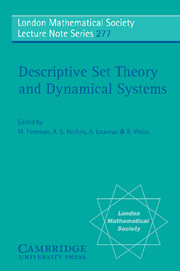Book contents
- Frontmatter
- Contents
- Preface
- 1 An Overview of Infinite Ergodic Theory
- 2 The Multifarious Poincaré Recurrence Theorem
- 3 Groups of Automorphisms of Measure Space and Weak Equivalence of Cocycles
- 4 A Descriptive View of Ergodic Theory
- 5 Structure Theory as a Tool in Topological Dynamics
- 6 Orbit Properties of Pseudo-homeomorphism Groups of a Perfect Polish Space and their Cocycles
- 7 Descriptive Dynamics
- 8 Polish Groupoids
- 9 A Survey of Generic Dynamics
1 - An Overview of Infinite Ergodic Theory
Published online by Cambridge University Press: 05 August 2013
- Frontmatter
- Contents
- Preface
- 1 An Overview of Infinite Ergodic Theory
- 2 The Multifarious Poincaré Recurrence Theorem
- 3 Groups of Automorphisms of Measure Space and Weak Equivalence of Cocycles
- 4 A Descriptive View of Ergodic Theory
- 5 Structure Theory as a Tool in Topological Dynamics
- 6 Orbit Properties of Pseudo-homeomorphism Groups of a Perfect Polish Space and their Cocycles
- 7 Descriptive Dynamics
- 8 Polish Groupoids
- 9 A Survey of Generic Dynamics
Summary
Abstract. We review the basic ergodic theory of non-singular transformations placing special emphasis on those transformations admitting σ-finite, infinite invariant measures. The topics to be discussed include invariant measures, recurrence, ergodic theorems, pointwise dual ergodicity, distributional limits, structure and intrinsic normalizing constants.
Introduction
Infinite ergodic theory is the study of measure preserving transformations of infinite measure spaces. It is part of the more general study of non-singular transformations (since a measure preserving transformation is also a non-singular transformation).
This paper is an attempt at an introductory overview of the subject, and is necessarily incomplete. More information on most topics discussed here can be found in [1]. Other references are also given in the text.
Before discussing the special properties of infinite measure preserving transformations, we need to review some basic non-singular ergodic theory first.
Let (X, B, m) be a standard σ-finite measure space. A non-singular transformation of X is only defined modulo nullsets, and is a map T : X0 → X0 (where X0 ⊂ X has full measure), which is measurable and has the non-singularity property that for A ∈ B, m(T-lA) = 0 if and only if m(A) = 0. A measure preserving transformation of X is a non-singular transformation T with the additional property that ra(T-1A) = m(A) ∀ A ∈ B.
- Type
- Chapter
- Information
- Descriptive Set Theory and Dynamical Systems , pp. 1 - 30Publisher: Cambridge University PressPrint publication year: 2000

